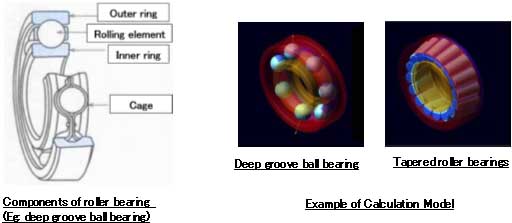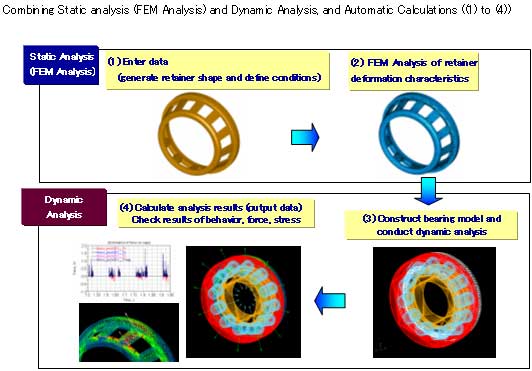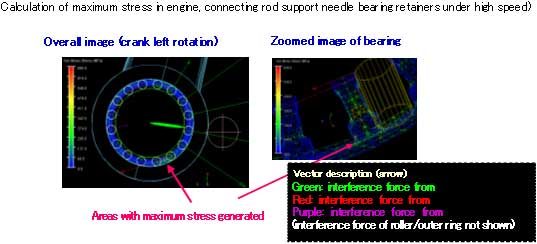
Development of the Industry's Highest Precision and Fastest Integrated Bearing Dynamic Analysis System (IBDAS)March 2, 2011
Faster designs with dynamic analysis of roller bearings while they are in motion!
NTN Corporation (hereafter, NTN) has developed the industry's most advanced Integrated Bearing Dynamic Analysis System (IBDAS) for use with ball bearings and roller bearings, allowing behavior and stress of rolling elements and retainers to be calculated while bearings are in motion - a feature that was not available with previous analysis or testing methods.
NTN uses IBDAS for greater precision and faster analysis of bearing specifications that meet customer requirements, as well as to improve design and proposal speed.
Roller bearings normally consist of an inner ring, outer ring, rolling element and cage, where the load on the inner and outer ring of the bearing is supported via the rolling element. Forces applied to the rolling element when bearings are stationary are calculated from the balance of forces and moments acting on the inner ring, outer ring and rolling element using Static Analysis. Yet the behavior and forces on the cage when bearings are in motion cannot be calculated with static analysis, and instead require Dynamic Analysis.
Dynamic analysis generally has only limited use during the design stage due to the immense figures and complex steps required for obtaining each set of data from bearings when they are in motion, and has not been used to calculate stress in the cage itself until now. Measurement of forces acting on the cage during testing has also not been conducted in practice due to difficulties faced for sensing.
The newly developed IBDAS allows accurate calculations of behavior and stress acting on the rolling element and cage when bearings are in motion, a feature that was not available with previous static analysis or testing methods. It achieves this by using Component Mode Synthesis* to deliver the industry's highest level of precision, and offers accurate and speedy analysis. The development of a proprietary calculation and control system allows for combination analysis of all types of roller bearings and composite bearings, switching between 2D and 3D modes, and has been designed for ease-of-use.
NTN has already started using IBDAS in bearing applications where the cage is subject to large contact forces, including various planetary reducers and engines. The system will also be used to design bearings that better meet customer requirements, including high load capacity bearings, long-life and high-reliability bearings, low-torque bearings and more compact bearings, with greater precision and faster analysis, as well as to improve design and proposal speed.
*) Component mode synthesis: one method used to analyze vibration phenomenon. Eigenvalue analysis is used to determine the eigenvalue (natural frequency) and eigenvector (natural vibration mode), with the stress on bearing structures (parts) due to variable external forces determined by superimposing the natural vibration mode.
Features (the industry's most advanced Integrated Bearing Dynamic Analysis System (IBDAS)
| (1) Allows deformation of cages and calculations of bearings while they are in motion |
|
|---|---|
| (2) Automatic calculation system compatible with all types of roller bearings |
|
| (3) Outstanding usability and data management |
|
Examples of bearing analysis
- Planetary reducer parts (behavior when revolving)
- Axle supports (analysis when subject to vibrations from the road surface)
- Engine, connecting rod supports (analysis when subject to vibrations from within internal-combustion engines)
Image of analysis of various types of roller bearings
Compatible with all types of roller bearings

Analysis Flow

Example of Analysis

